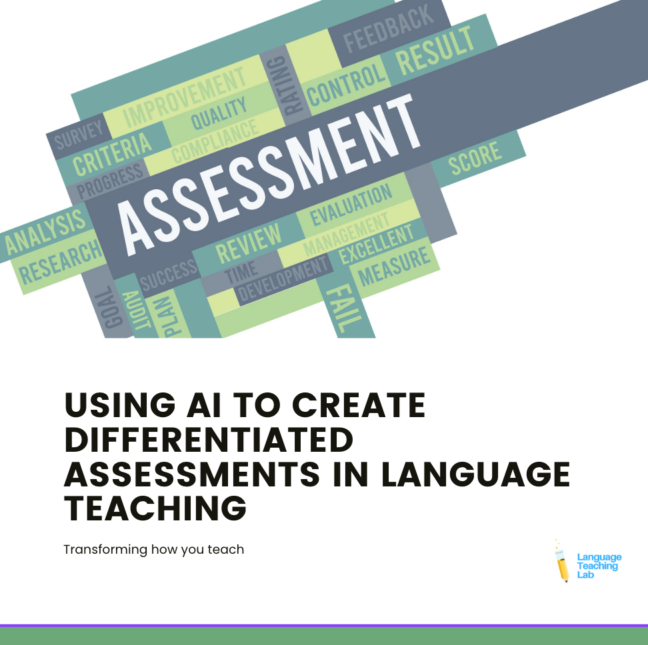by Maureen Gassert Lamb (LTL Contributor)
As educators strive to meet the various needs of students in language learning and acquisition, differentiation in assessment has become essential. Generative Artificial Intelligence (AI) offers a powerful tool to create personalized, adaptive assessments that align with learners’ proficiency levels. This article explores how AI can be leveraged to design differentiated assessments, ensuring meaningful, impactful, and effective language assessment.
AI technology enables educators to create assessments that cater to various proficiency levels by generating customized questions, passages, and real-time feedback. Through adaptive learning techniques, AI can modify assessments based on students’ responses, ensuring that they are challenged appropriately while receiving necessary support to thrive.
1. AI-Generated Reading Passages Aligned with Proficiency Levels
One of the most effective ways AI supports differentiation is through the creation of tiered reading passages. By adjusting vocabulary, syntax, and complexity, AI can generate texts that match students’ proficiency levels.
- Novice Level (Basic Sentences, Simple Structures)
- Example (Topic: Daily Life in Rome): “Romani in urbe magna habitant. Multi viri et feminae in foro ambulant. Ibi cibum emunt et amicos salutant. Pueri in ludo discunt.”
- AI Tool: ChatGPT can generate beginner-friendly texts with controlled vocabulary and structure.
- Intermediate Level (More Complex Sentences, Some Subordination)
- Example (Topic: Aesop’s Fable – The Tortoise and the Hare): “Olim testudo et lepus certare volunt. Lepus celeriter currit et testudinem ridet: ‘Tu es tardissima!’ Sed testudo lente et constanter ambulat.”
- AI Tool: QuillBot can help rephrase sentences for increased complexity.
- Advanced Level (Subjunctives, Participles, Indirect Discourse)
- Example (Topic: Julius Caesar and the Rubicon): “Cum Iulius Caesar Rubiconem transiret, milites eum sequebantur. Dicebat: ‘Alea iacta est!’ Senatus Romam servare conabatur, sed Caesar urbem sine magno proelio cepit.”
- AI Tool: ChatGPT and DeepL can refine passages to include complex grammatical structures.
2. AI-Generated Question Types for Various Levels
AI can create multiple-choice, open-ended, and inference-based questions that align with language proficiency benchmarks.
- Novice: Focus on basic comprehension and word recognition.
- Example: What do the Romans do in the forum?
- A) Sleep
- B) Walk ✅
- C) Eat
- D) Fight
- AI Tool: Google Forms + AI-based question generators like Quizlet.
- Example: What do the Romans do in the forum?
- Intermediate: Introduce sentence structure analysis and cause-effect relationships.
- Example: Why does the tortoise win the race?
- AI Tool: AI-driven platforms like Quizlet and Kahoot! can generate dynamic quizzes.
- Advanced: Require inferencing, paraphrasing, and interpretation of nuanced meanings.
- Example: How does Caesar’s decision to cross the Rubicon reflect his leadership style?
- AI Tool: Brisk Teaching AI tools help generate higher-order thinking prompts.
3. Adaptive Assessments for Personalized Learning
AI-powered assessments can adjust in real-time based on student responses. If a student struggles with a concept, AI can generate additional scaffolded questions or provide explanatory feedback. Conversely, if a student excels, the AI can present more challenging questions to encourage deeper engagement.
- Example: If a student consistently answers correctly at an intermediate level, AI can introduce an advanced-level passage and related questions.
- AI Tools: Conker offers AI-driven question banks. Quizlet can give feedback to track progress in real time.
4. Using AI for Formative and Summative Assessment
- Formative Assessments: AI can provide immediate feedback, helping students understand mistakes and adjust their learning strategies accordingly.
- Summative Assessments: AI-generated tests can evaluate students’ overall progress while ensuring alignment with proficiency standards.
- Example: AI generates an end-of-unit comprehension test with a mix of multiple-choice, short-answer, and essay questions.
- AI Tool: EdPuzzle for AI-enhanced comprehension checks.
5. Best Practices for Implementing AI in Language Assessments
To maximize the benefits of AI in assessment, educators should ensure that AI-generated questions align with proficiency guidelines such as ACTFL standards. They should use AI to generate varied but plausible answer choices that challenge students while focusing on comprehension rather than simple translation-based questions. Additionally, leveraging AI tools that adapt to students’ learning trajectories allows for personalized feedback and continuous improvement. By thoughtfully integrating AI into assessment strategies, educators can create meaningful, proficiency-aligned evaluations that support diverse learners in their language acquisition journey.
Generative AI presents an innovative approach to differentiated assessments in language education, allowing teachers to create adaptive, proficiency-aligned evaluations. By leveraging AI’s capabilities, educators can support students at all levels, enhancing their language acquisition journey through personalized learning experiences.
